Social media has revolutionized the way people sell.
It’s created ample opportunities for large corporations to reach their customers on a personal level.
Conversely, new social media platforms in 2020 have created opportunities for entrepreneurs and small businesses to compete on a global scale.
Like all areas of digital marketing, social media is continuously evolving. Platforms that were once dominant in the industry are being forced to share the wealth as new platforms enter the arena.
Here are several new social media platforms that marketers should become familiar with in 2020 and beyond.

FREE DOWNLOAD 👉 The Facebook Ads Asset Library! All the checklists and guides used to profitably spend $150M+ on Facebook & Google ads.
Established Social Networks
Before you can jump into any new social network, take a look at some of the already established platforms.
If you are a business that is trying to grow its brand on social media, then its best to do some research first.
Find out which social network is best suited for your brand. For example, which social network has your target audience?
You can get an idea by looking at your competitors to see which social network they are on.
If you are already established on the popular social networks, then perhaps you can experiment with some of the newer ones below.

TikTok
TikTok joined the world of social media platforms with little fanfare during 2017. It wasn’t until a merger with the Musical.ly app in 2018 that the app became a seemingly overnight success with users. The app allows quick comedic bits and lipsyncs ranging from 3 to 60 seconds in length.
Many feel that TikTok has filled the gap left by the failure of Vines in 2016. Vines allowed for a 15-second clip, often showing music and comedic bits.
This platform had over 200 million users when Twitter pulled the plug. TikTok has over 1.5 billion downloads and 500 million active users, according to Hootsuite’s 2019 Global State of Digital Marketing report,– more than Pinterest, Snapchat, LinkedIn, Reddit, and Twitter.
Aside from the obvious audience size, TikTok has many benefits for marketers– primarily, that this market is largely untapped for business purposes. In this way, users aren’t facing the same fatigue from seeing sponsored posts and ads, the way they are for older platforms.
While brands still favor Instagram for it’s quick, visual punches, many users are becoming resistant to the platform. As consumer awareness grows surrounding influencers and Instagram marketing efforts, trust decreases.
Furthermore, consumers are getting tired of the highly polished “Instagram aesthetic” and looking for levity and authenticity; TikTok offers both.
TikTok is successfully putting the freshness and fun back into social media for younger generations. It’s interactive engagement style allows for a wide variety of novelty topics to trend easily, like the lip shape chart, and popular dance challenges, for example.
A Young Audience
TikTok also has a younger target audience than many social media platforms, creating incredible opportunities for youth-oriented brands. Gen Z has never lived in a world without the internet and social media, and Musical.ly/ TikTok has primarily been “their”platform.
While Gen Z might not control the household purse strings, TikTok creates a marketing opportunity similar to the television toy ads that worked so well in the 80s and 90s.
Finally, the most significant opportunity for brands using TikTok is that the authenticity and untapped potential translates to low costs.
As video marketing is one of the best SEO strategy focal points for 2020, being able to send a quick, simple challenge or video into cyberspace with a brand attached is pure gold.
It will likely be a few years before TikTok crosses their t’s and dots their i’s when it comes to paid marketing and sponsorship opportunities. Creating an organic following and testing the waters now should be a focal point for brands as 2019 becomes 2020.

BYTE
Byte is the second coming of Vine, created by Vine’s co-founders.
Like Vine, it’s a platform for looping 6-second videos. While it’s not taking off (yet), it launched with some fanfare, and already has mini celebs trying to take a stab at creating content for the platform.
Already it has over a million downloads, which shows that there’s a demand for a revitalized version of Vine.
This is one platform that seems exciting since it will focus on the creativity of the creators from day 1. Vine always had a strong creative community, whereas Tik Tok seems less about creating “art” and more about mindless videos.
Stay tuned as we keep you updated on what’s going to happen with Byte in the near future.
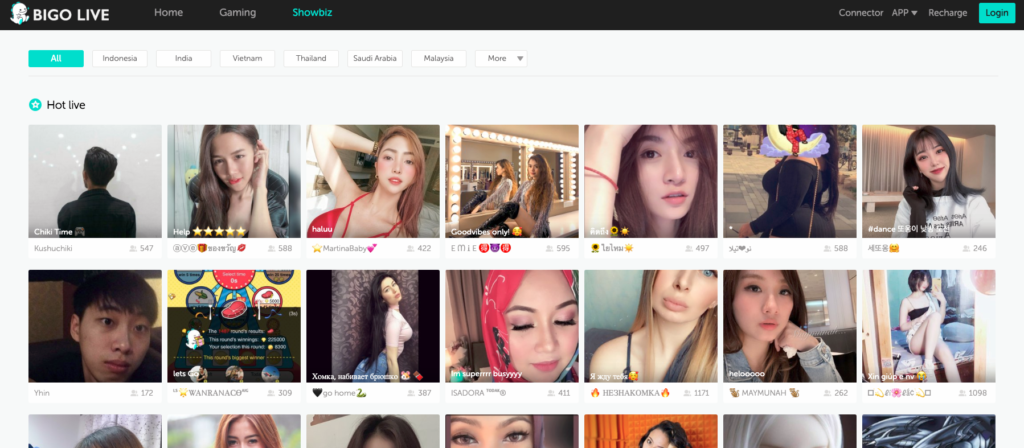
Bigo Live
Bigo Live is live streaming cams… without nudity. The platform is MASSIVE overseas and in Asia, and is getting a foothold with various countries, including the US.
The main thing that appeals on this platform is streamers can make money talking to their fans, and there’s already a lot of them on there.
A large majority of the audience is beautiful young ladies, but now it’s at a point where almost anyone can create a channel, stream themselves, and make money if they’re interesting enough.

Twitch
Twitch entered the playing field in 2011 as nothing more as a spinoff of one of Amazon’s other pet projects. However, it wasn’t until the last year or so that it grew exponentially and got noticed for the marketing opportunities it presents.
Twitch is a live streaming service that was primarily put in place for gaming. Twitch users could stream their progress while participating in various online games, addressing the needs of an extremely niche market.
Today, however, Twitch as over 15 million active daily users. It’s worth noting that 81.5% of Twitch users are male, according to Influencer Marketing Hub. What makes this statistic so intriguing is that the majority of social media platforms have an even split between male and female users, often slightly trending toward more females.
So what’s the opportunity for such a niche platform? First and foremost, there’s a huge opportunity to reach the male demographic, regardless of your brand’s relevance to gaming.
Creating a customer avatar that outlines similar interests (i.e., an adult male aged 30-34 who is interested in gaming is typically also interested in x,y,z) can highlight the opportunity for targeted advertising.

Influencer Marketing Opportunities
The second opportunity lies within the sphere of influencer marketing. Similar to YouTube influencers, businesses can investigate ways to work with trending broadcasters to promote their products or services.
Finally, businesses can look for areas of overlap. Many organizations, both small and large use Twitch as a secondary platform for webinars and lead magnets within the tech industry.
Software developers, for example, will often include Twitch in their live streams outlining relevant tutorials and presentations.

While video marketing is growing, live streams are the next step up. If you worry that Twitch might be too niche for your liking, consider the fact that both KFC and Old Spice have run successful campaigns using the service.

Houseparty
Houseparty has been the subject of some controversy over recent years. It was initially introduced to the market as a rebranded version of Meerkat in 2016.
This platform is a video messaging service that allows up to eight users to come together in a virtual environment. The platform offers special effects similar to Snapchat, including filters and graphics.
While Houseparty got off to a strong start, it was facing established social media giants like Facebook and Snapchat. When these two competing platforms launched group video chat options, Houseparty started to see a drop-off in users.
However, that’s changed since a partnership with Ellen Degeneres in the summer of 2019 cross-promoting with her widely regarded “Heads Up” app. The Houseparty integration allows people to play the game from remote locations, improving revenue for both partners.
Since that time, Houseparty users have taken it upon themselves to explore other opportunities for shared remote experiences. Users have been recorded playing other games like Cards Against Humanity, and even watching shared Netflix shows from separate viewing locations.
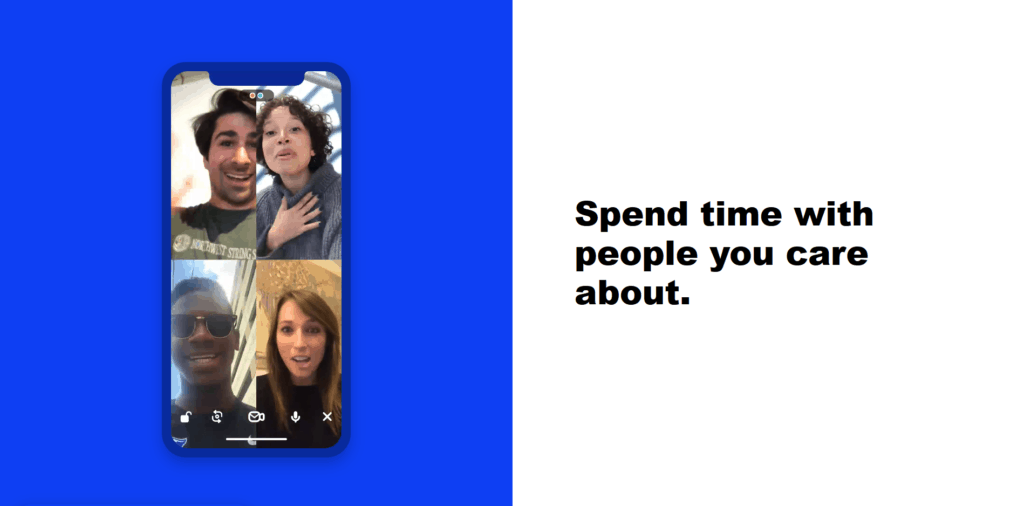
While things weren’t looking good for Houseparty in 2018, it’s expected that this app will bring significant marketing opportunities in 2020 and beyond.
A Next-Gen App
Like TikTok, the majority of Houseparty users are from Gen Z, making this platform an up-and-coming way to market to the next generation. Furthermore, the success of the partnership with Heads Up will likely lead to future collaborations with other notable apps and services. By strategizing now, marketers can get ahead of the competition.
While there’s an option for paid sponsorship within the app, the real opportunity is its sense of exclusivity. As online tutorials, courses, and live streams continue to grow, Houseparty is the perfect online platform for selling small, exclusive interactions with an already engaged audience.
It’s worth noting that the exclusivity of the video chat group size has a flip side. While Houesparty could be an excellent tool for customer engagement and retention, the current platform is not ideal for new customer acquisition.
The average Houseparty user only has 23 contacts. However, they tend to have a higher daily usage rate than other social media platforms. Of course, their recent success could lead to changes that create new opportunities in the future.

Vero
Instagram continues to be a major contender in social media marketing. However, both businesses and users have one major pain point: algorithms. It’s this same issue that’s driving so many companies away from Facebook– algorithms make it harder to see what you want to see, with favor being given to paid advertisers.
Enter Vero, an app that promises “True Social” and makes authenticity and transparency a major focal point of its unique selling proposition. This app, like Instagram, is only accessible via mobile devices.
Unlike Instagram, Vero claims not to use algorithms and doesn’t promote sponsored posts or advertisements. Instead, posts appear chronologically: the latest post is what you see first, regardless of whom you follow. However, that doesn’t take it out of the running for marketers.
Vero creates a new opportunity in influencer marketing. The focus can once more return to building an engaged audience by creating high-quality content.
For marketers with a limited budget that creates barriers when advertising on Instagram, Vero could be the solution.
Another thing that sets Vero apart from the competition is the post “collections.” In many ways, Instagram is still behind the ball in modern marketing. As of 2019, there’s no ability to incorporate a link into a static post.
Those with 10,000 or more followers can circumvent this challenge by adding a link to their Instagram Stories.
Of course, with the prevalence of follow/unfollow and ghost accounts, it can be hard for businesses to gain the traction they need to hit that number.
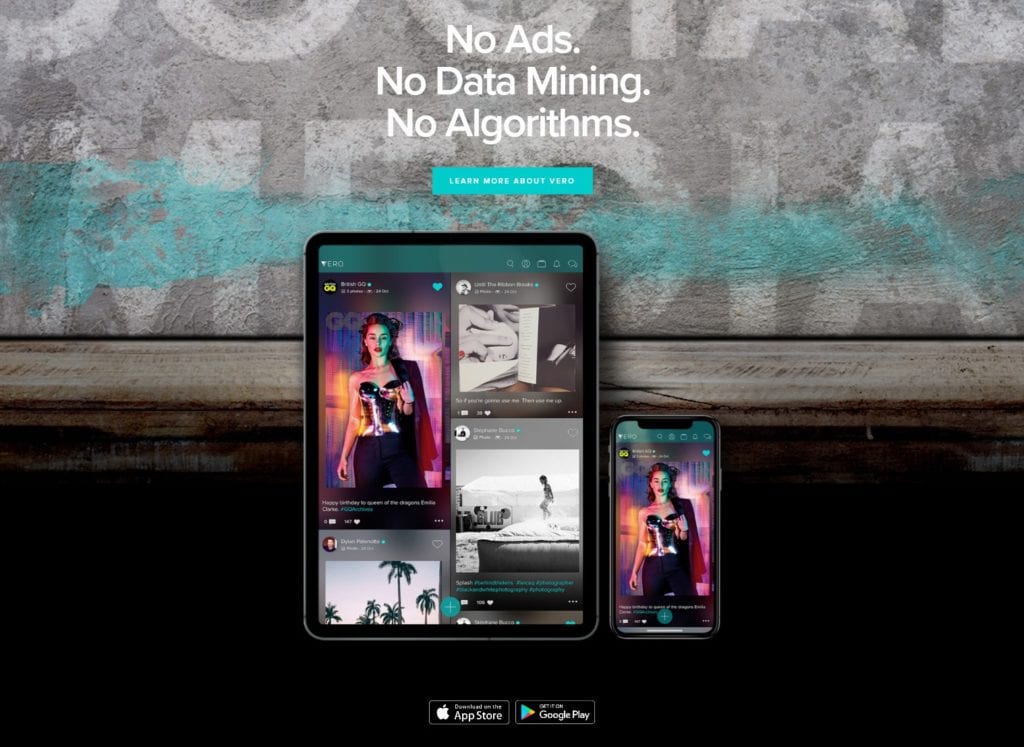
With Vero’s collections, content is sorted into:
- photos/videos
- links
- music
- movies/tv
- books
- places
Not only does this create an opportunity for niche marketing, but it also allows link sharing.
Enhanced Security
Users also enjoy the feeling of enhanced security. While businesses can maintain a public profile that users can follow, the user can limit their audience through filtration. Like Facebook, Vero offers segmentation through friends, acquaintances, and close friends. As consumer awareness surrounding privacy protection grows, this system is a selling point.
As with any platform, there are some caveats for marketers to consider. To start an account, you must enter your phone number. While many internet-savvy consumers are willing to part with their email address, there’s more friction when it comes to parting with their phone number.
While Vero argues that it’s necessary to reduce the number of ghost accounts and bots that make Instagram so problematic at times, consumers aren’t buying it.
The other consideration is that Vero’s original business model was subscription-based to generate revenue without ad sales. However, social pressure forced them to remove that barrier to entry.
Thus the question has to be asked: is the platform sustainable? How long will it be until Vero has no choice but to accept paid sponsorships?
It’s estimated that Vero has somewhere between 4.5 and 5 million users, though the company doesn’t make it easy to find specifics. A tip for marketers: test out some current Instagram campaigns on Vero, run the analytics, and make some strategic decisions based on the results.

Lasso
Facebook is keen on world dominance. For every aspiring social media startup, Facebook has the resources and drive to nip it in the bud. Take Instagram, for example.
The platform had one million users within two months of its launch date in 2010 and ten million users by the end of its first year. Facebook snatched it up for a cool $1 billion price tag in 2012.
Lasso is Facebook’s answer to TikTok. As mentioned previously, TikTok has seen exponential growth since its successful merger with Muiscal.ly.
This creates a challenge for Facebook, which is often viewed by Gen Z as the older generations’ platform– a view that makes sense as most of Gen Zers don’t remember a world without it.
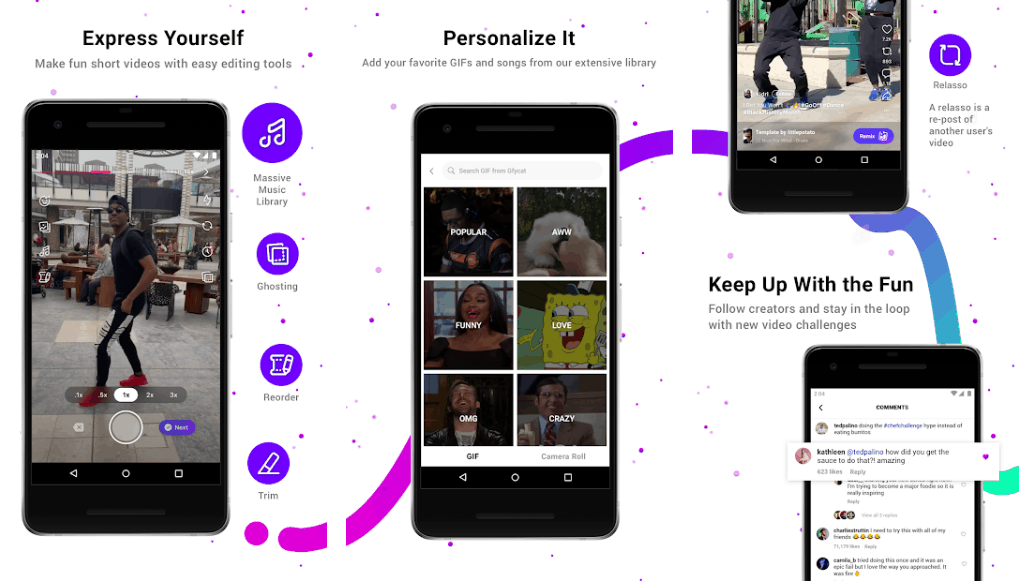
Should Marketers Use Lasso?
So why should marketers care about yet another short-form video app? The answer: it’s too much of a gamble not to care. Yes, TikTok is experiencing a meteoric rise to the top.
However, Facebook has the power to change that over time. If you already have ample resources invested in Instagram and Facebook marketing, it might be worthwhile to have a streamlined approach as the multimedia giant creates integrations.
However, this is far from the first time Facebook has released an app as a knee-jerk reaction with mixed results.
App marketing intelligence firm SensorTower reports that in January 2019, TikTok had 6.4 million downloads in the US, whereas Lasso only had 15,000. You might remember the Slingshot app they launched as a response to Snapchat– more likely, you won’t because it was a total failure.
While there’s a lot up in the air between the two platforms right now, Facebook’s latest hire might be a gamechanger. In summer 2019, Facebook welcomed Jason Toff to the team.
Toff was a big wig with Vines in the early days and left Google to pursue this position with Lasso. While TikTok’s parent company has deep pockets, Facebook isn’t backing down without a fight.
So, what should you do as a marketer? Play around with Lasso and see if it merits any results. As with Vero, compare the results and stay abreast of the breaking news before putting all of your eggs in one basket.
Where Should the Focus Be?
In an ideal world, marketers would be able to jump at the opportunity to explore every new method for reaching customers without detracting from current strategies and courses of action. Of course, that’s not the reality for most businesses.
Marketers have to contend with an overall budget within an organization.
However, there’s also the consideration of other digital marketing efforts outside of social media and non-digital marketing costs. With those limitations in mind, what’s the best course of action.
For most marketers, the answer is simple: now isn’t the time to take action. However, taking the time to become aware of these different platforms and stay up-to-date as they develop will help you decide when the time is right.
This knowledge can drive some secondary research to keep on file until it’s ready to move off the backburner. If resources can be reallocated, putting a small budget toward investing a few new options is worthwhile.
Targeting Gen Z
At present, Millennials make up a considerable portion of the market share for most industries. As a result, it makes sense to have the majority of marketing efforts pointed in that direction.
However, Gen Z is on the rise. With the eldest of this generation reaching their 25th birthday within the next couple of years.
A Bloomberg analysis reports that by the end of 2019, Gen Z will finally outnumber the Millennials, making up an estimated 32% of the global population– Millennials account for 31.5%.
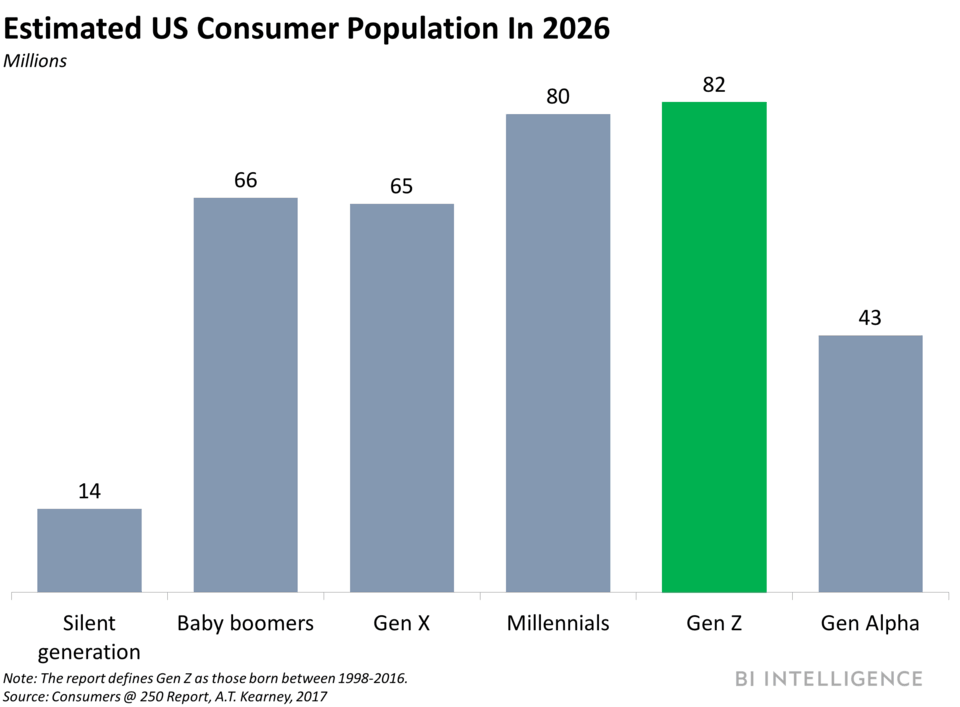
Gen Z brings with it a new set of values and traits. While Millennials were the first generation of the internet age, Gen Z has known nothing else.
They’ve been able to observe the Millennial generation. Particularly in relation to social media trends and faux pas, which will direct their purchasing decisions.
As they age, Gen Z will have different expectations for businesses if they’re expected to part with their money. Marketers will have to find ways to prioritize:
- Authenticity – the bells and whistles of social media marketing are tired. Gen Z has seen all the tricks and prefers a human approach to the digital age.
- Personalization – with the insurgence of AI and machine learning, we’re at the dawn of an era where each customer might have a different shopping experience with the same company. Add in the increased accessibility of VR platforms, and immersive customer experiences start to look very different.
- Conversation – it’s not enough to be sold to or talked at anymore; Gen Z consumers want engagement and conversation. Marketers will have to focus on quality over quantity; it’s better to have a small, engaged audience than massive amounts of followers in the years to come.
Get in on the Ground Floor
One of the most compelling reasons to start looking at the social media platforms of the future is to get a leg up on the competition.
Having a general idea of where the future focus might be, as well as knowledge surrounding the content you’ll need to produce, makes it easier to start when these trends take hold.
A successful marketer is always thinking ahead, and the future is now.
Which social media platform is your favorite? Have you tried any of the social media platforms listed above? Tell us in the comments below.
About the Author
Wendy Dessler is a super-connector who helps businesses find their audience online through outreach, partnerships, and networking. She frequently writes about the latest advancements in digital marketing and focuses her efforts on developing customized blogger outreach plans depending on the industry and competition.
Jack Paxton is the co-founder of VYPER, a marketing tool that helps brands build email lists, social followings, and revenue using viral giveaways, referral, and reward programs. After millions of dollars spent testing different marketing strategies at his marketing agency. He then also co-founded Hyax a fast, conversion & design-focused course and funnel builder for creators.





Trackbacks/Pingbacks